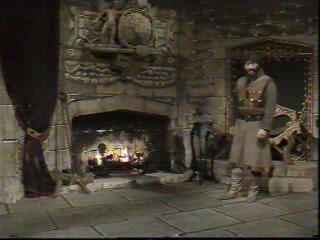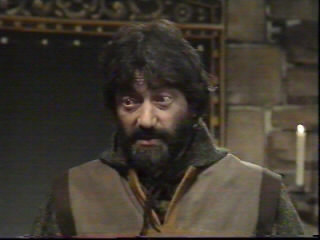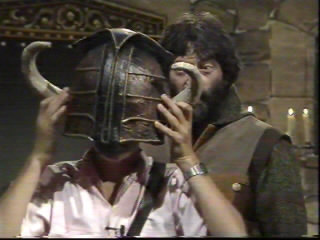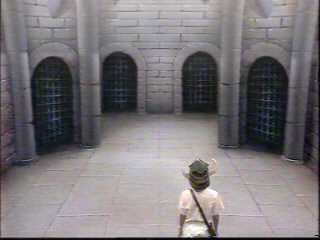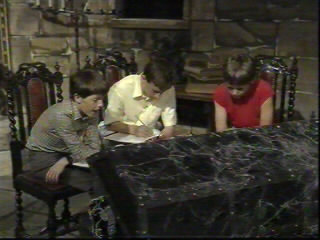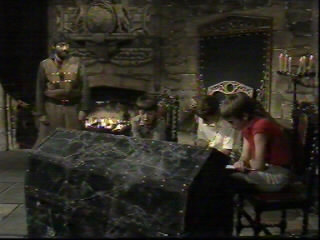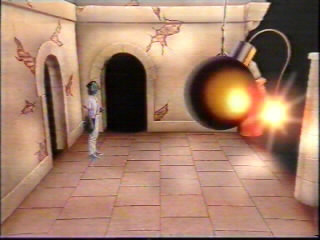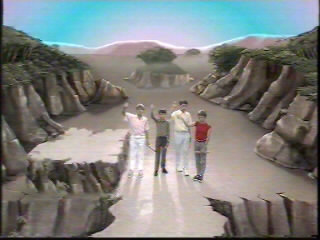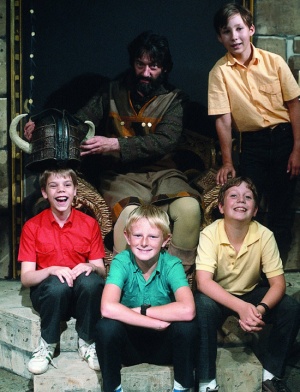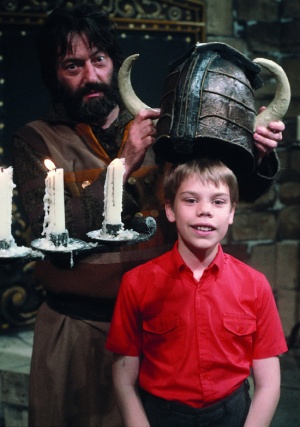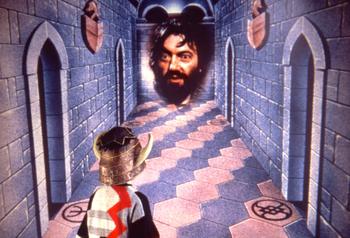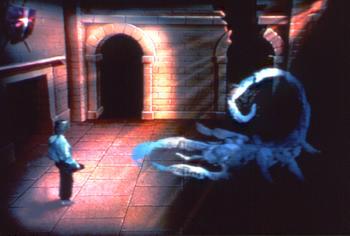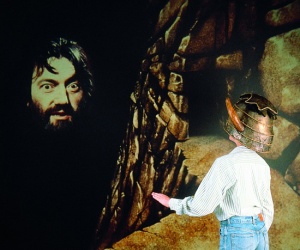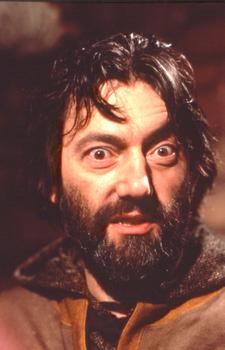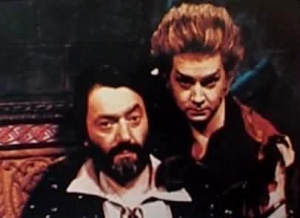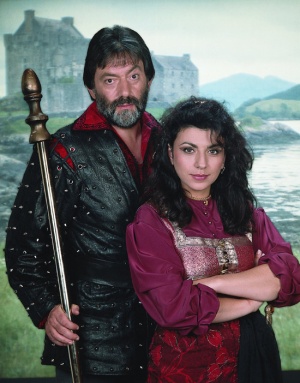Knightmare

Contents |
Host
Treguard of Dunshelm (Hugo Myatt)
Co-hosts
Series 4-6: Pickle the Elf (David Learner)
Series 7-8: Majida the Genie (Jackie Sawris)
Broadcast
Broadsword Productions and Anglia for ITV, 4 September 1987 to 11 November 1994 (112 episodes in 8 series)
Synopsis
Of all the game shows in the whole A to Z, few have had the impact on their fans as Knightmare. For Knightmare was original (gasp!), innovative (shock!) and even exciting (my word!)
Inspired by computer games, Knightmare utilised blue screen technology to create an adventure. It was a show that made a point about its potential disability - the person inside the game wouldn't be able to see any of the graphics so they were made to wear "The Helmet of Justice" (no Dale Winton jokes, please) so they couldn't see much of their computerised fantasy environment anyway. Brilliant!
The entire show was set in the Dungeon ante-chamber where Treguard, Lord of Knightmare Castle and Master of the Dungeon would preside (along with Pickle the Elf in series 4-6 and Majida the Genie in series 7-8). On the immortal words of "Enter, Stranger" a child would enter the room, magiced from our world. He/she was the Dungeoneer and would enter the Dungeon. However, to guide him they would have three advisors (team-mates) who would magically appear on their names being called. The Dungeoneer would then be given several things:
The Knapsack: This was for keeping any food that was picked up. The Dungeoneer was governed by Life Force, its manifestation of which changed over the years. In the first 5 series it was a picture of a knight's face, which after the armour fell off the skin would then gradually peel away leaving a skull. Once the entire skull disappeared and the eyes went, that's it, you were dead. In series 6 it changed to a knight in shining armour and the armour would start dropping revealing a skeleton, and once all the armour went the skeleton dropped dead (as did the Dungeoneer) and in the eighth series it was a pie, slices of which would disappear. Not nearly as good, that one. Also in that final series Dungeoneers were allowed to carry other objects in the Knapsack, something they weren't allowed to do before.
The Eye-Shield: When the show started taking the Dungeoneer out of the Dungeon in series 4, the only easy way they could think of getting from one place to another was The Eye Shield, which showed the team (but not the Dungeoneer) where he/she was going (when in fact the Dungeoneer wasn't really going outside). Whilst many people liked this, it came with the introduction of better graphics and digital film, the same amount of people again DISliked it saying that the introduction of going outside lost some atmosphere.
Reach: In the show's eighth and final series, the Dungeoneer was given a magic wand called Reach that enabled the Dungeoneer to push, touch and (yes) reach things they may not be able to do normally. Because the final series saw a welcome return to computer generated puzzles, the wand worked well. When the player wanted to use it, a crosshair would appear and depending on how the wand was guided the crosshair would move accordingly. When it was in the right place, the Dungeoneer would press a button and the required thing would happen. Given the correct object, such as a key, you could open the door from the other end of the room as well. Actually, watching the show closely, it has more to do with the way the advisors advise where it goes as opposed to what the Dungeoneer actually does...
The Helmet of Justice: An important piece of equipment because it protected the wearer from the "Illusions of the Dungeon". Or rather, to stop them from realising that the whole room was blue.
Level 42? - not quite
The game structure involved guiding the Dungeoneer through the three levels of the Dungeon. To do this, the three advisors would have to direct the Dungeoneer around from the safety of their ante-chamber. The Dungeoneer could see all real objects directly below him or her by peering down past their nose, but nothing else. To get from one level to another they had to use a wellway, a lift ('The Descender') or any other way down.
Each level had several rooms, each one containing a puzzle, a trap or an encounter with another character and sometimes a mixture of the above. In the first four series the level 1 clue rooms would be guarded by a Wall Monster who would ask riddles and threaten to eat the Dungeoneer if they didn't get them right. One correct answer would allow them to pass, and two or three would give them useful extra information. They could also pick up two of three/four objects offered to them on a table, which they would use later to help solve puzzles, disarm traps, or give to other characters to rub them up the right way.
Puzzle panel
Puzzles in Knightmare were, on the whole, excellent and normally took the guise of either riddles or floor puzzles. In series 5 and 6 this included causeways, large hexagonal grids above a huge you're-gonna-die pit. Each stone on the causeway was marked in some way and the advisors had to guide the Dungeoneer onto the correct hexagons, because once a hex was left all the wrong ones behind the Dungeoneer just dropped (and if they were on a wrong one - BONG! instant death). The way to find the route was to follow a logical progression (Rock, Scissors, Paper etc...). In series 6 the Causeways had an extra frisson added to them by way of a Frightknight clock, which upon expiry would cause rocks to fall automatically.
Other puzzles of note include the Trial by Spikes (series 7), a game where they had to obtain a combination to get across a room of spikes which disappeared into the flagstones for a short time in order for the Dungeoneer to get through...and then they'd all pop-up again, save for a single flagstone which stayed safe.
And then there was Play Your Cards Right (series 7-8) where the Dungeoneer would be standing on a block next to two huge playing card buttons. One of which would bring the next block forward to stand on, the other one sending the Dungeoneer to certain death.
Booby trap
In addition to mental games, there were traps which involved good communication between the team and the Dungeoneer. These were normally timing games, where the team would guide the Dungeoneer around a room full of pointy-looking things in order not to get stabbed, squashed or otherwise mutated. Of course, death was only virtual death, but to the viewers even virtual death was scary enough...
A simple form of trap was the Bomb rooms. (Series 1-3) Panic-inducing in its efficiency, a big bomb would be evident in the room and it was simply a case of get out quickly or be blown up.
More complex versions included the legendary Corridor of Blades (series 4-8), whereby the Dungeoneer would be on a conveyor belt in a tunnel. Circular saws would then start coming towards them. The advisors would then have to shout to the Dungeoneer to run to the safe wall (right or left) in order to dodge the blades, because like in life, getting your legs chopped off by a large circular blade (animated, of course) inevitably ends in death.
Help is at hand
Helping the teams not to make too many stupid mistakes was Treguard, who, after all, owned the Dungeon. He played an interesting and changing role over the years. In the first few series, the object of the game was to defeat his Dungeon and whilst he would often help, he would also be quite sadistic and was capable of some marvellous overacting. It was in the nature of evil to oppose good and so there was also Mogdred, a major baddie in the Dungeon with a magnificent booming laugh trying to kill off the team. In series 5 Mogdred mysteriously disappeared and so a new Big Baddie filled his shoes from then on, he who was Lord Fear.
By the time Lord Fear came along the show had already become more than spelunking through the dungeon, it now involved going through castles and other places which inevitably led to places like The Black Tower of Goth or The Great Fortress of Marblehead and the object of the Quest, guarded with a meeting with Fear itself.
Nostalgia mode... on
It is only with retrospect you understand how excellent the writing and acting on the show was. Treguard was excellent, his assistants were great (even if some people didn't like them) but the person with all the best lines was Lord Fear. Near the end of some later successful quests they'd meet him and sometimes he'd invite the Dungeoneer to beg a bit while he prepares some fireballs: "Now I don't like to gloat... what am I saying? I can't believe I said that, dear me, what a little fibber I am! Of course I like to gloat, I love it... you haven't had much food recently, and soon you'll begin to starve, so I'm just going to sit here and watch you die, and of course I'll gloat a bit." Excellently, the team will have usually picked up a spell or potion which would beat him and then they'd pick up the Quest Object and then race back to the dungeon before their Life Force runs out (hilariously there would sometimes be a long drawn-out floor puzzle against the Life Force clock which they would inevitably do just in time).
You may think from the above that many teams won. Wrong. In eight series, you could count the amount of teams that beat the Dungeon on the fingers of two hands (only 8) and so the people who did win were very special indeed and won prizes- 'Silver Spurs of Squiredom' in the first few series, Medallions in series 4, and Frightknight trophies after that. It was difficult, although there were many reasons why some teams failed, the main ones being not being quick enough to interpret the information, lack of communication or just plain thickness. Treguard gave as many clues as he was allowed to give (because he too was bound by the rules of "The Greater Game" as it came to be called) but did they listen?
Perhaps the mark of a truly great show is that the game itself was actually (when you think about it) extremely linear. But you didn't ever give a damn about that because you were too interested in what was actually going on and there was a real buzz by the time a team would get to Level 3 because, you know, they might do it. Many teams lasted several episodes (each show was over 25 mins long, at the end of each would be "Temporal Disruption" where time in the Dungeon stops for a week) and it was quite a shame when they died, only to be met with Treguard's "Spellcasting: DISMISS".
To be honest, it's a show we could talk about for days. In its heyday the show pulled over 5 million people, which even today is extremely impressive for a kids show. It has many fans from all ages having a certain kind of appeal, and new fans are continuing to emerge thanks to repeats of the show on Challenge. A remake was bound to happen eventually...
A virtual return
2004 saw the release of 'Knightmare VR' across the Internet, a pilot for a new Virtual Reality remake of the show (hence the 'VR'...well, what did you think it stood for, Victoria Regina?). Everything was computer generated, the rooms, the props, the dungeoneer...yes, the dungeoneer, technical wizardry now rendered the dungeoneer as a 3D avatar who could now actually see, meaning an end to the ol' Helmet of Justice. The only thing that wasn't a bunch of polygons was the dungeoneer's advisor (just the one now), even Treguard wasn't safe, getting his job pinched by some orc guy, losing his body and relegated to a disembodied head ala the Gamesmaster except not as cranky and not Patrick Moore. That said, it was good to see Hugo Myatt play him again, and even Mark Knight returned as the similarly CGIed up Lord Fear.
The trouble is, it really wasn't that good. Now the dungeoneer could see there was absolutely no point for an advisor anymore, they could just do everything themselves with no guidance needed. The music was also rather odd, ranging from nice 'n' dark moody undertones to this insane funky 60s organ piece in the dwarf tunnels, the latter of which just not fitting the show at all. (The proposed theme tune was later discovered on the net, and was basically just vocals of 'Knightmare! It's a Knightmare!' sung repeatedly to the tune of the musak, and subsequently acheived major 'so bad it's good' fame with KM fans). That said, there were some good bits, such as the awesome 'Slice Me Dice Me' floor puzzle with swinging axes and everything.
On the whole, though, it was clear to all that the old blue room+chromakey style worked better than all VR, something Tim Child himself later admitted. It didn't get picked up by any broadcasters, and remains an interesting curiosity in the world of KM. Maybe had they had a puzzle involving 22 boxes, it might just have worked...
The future of the past.
Key moments
An advisor from the seventh team in the second series having trouble dispelling the word "SHROUD" that Mogdred cast on the dungeoneer during the team's encounter with him, they forgot the letter "O" in the word, even Treguard tried to help them without giving too much away while paralyzed under Mogdred's power.
"Simon, sidestep to your left" says an advisor from the fourth team in the fourth series during the Block and Tackle chamber, leading the dungeoneer down the pit where the floor once was. Even Treguard couldn't hold back his disappointment with the words "You were never good at manoeuvring, were you?"
The entire quest from the last team of the seventh series with Barry's masterclass improving with the cast as a Dungeoneer as well as his really fun and lively advisors.
Catchphrases
Treguard usually starts and ends the show with a speech that was looped throughout the first series but was dropped after it concluded its run.
Start of show
Welcome, Watchers of Illusion,
To the Castle of Confusion.
Faze across time with us once more,
For this is the age of adventure.
I Treguard, Master of the dungeon, gift you audience.
Watch now you armchair adventurers.
While others braver than yourselves,
Challenge the secrets of my lair.
A quest is now in progress,
So here's a progress report.
(Treguard gives us the progress report)
And now, Time turns,
The fire burns,
(Fireplace starts going after it stops freezing)
Time out is gone,
The quest...IS ON!
End of show
Warning team, complete temporal disruption approaching!
Time is now the enemy.
(looks over to fireplace, which freezes)
(looks back to camera)
Oh dear, temporal disruption complete.
Time flies as the Romans would say.
And although all continues in your world,
Here time has flown.
All adventuring must now cease,
Until you faze with us once more.
Will our team triumph in adversity?
Or will the dungeon win once more?
And if so, why should you care?
For here, nothing is real.
And all must surely be an illusion.
Join us again for Knightmare.
And just keep telling yourself...
It's only a game...ISN'T IT?
Whenever a team died in a dungeon chamber, Treguard would flip flop between two phrases, they were either the OK but less memorable, "Oh dear! What a pity. Never mind!", or the legendary, "Ooh, nasty!"
Whenever Treguard introduces a new team he says "Enter, Stranger!", he says this for the first 6 series until Majida took over saying it in series 7.
In each chamber the dungeoneer enters, they would utter the words "Where am I?", followed by one of the advisors saying "You're in a Room".
Inventor
Devised by producer Tim Child.
Theme music
Composed by Ed Welch.
Trivia
The show was originally going to be called Dungeon Doom but happily Tim Child saw sense.
Two foreign versions existed with rules of their own: La Chevalier du Labyrinthe (the French one) and El Rescate del Talisman (Spanish). There would have also been an American version too, called "Lords of the Game", but this never got past the pilot stage.
The first series of Knightmare caused a bit of controversy as Mary Whitehouse was pushed into saying that it was an evil show by the evil tabloids. She apologised when she actually saw the show, though.
In the first series, Anglia Television came unstuck when it came to producing some of the computer graphics...because they had no computers! Therefore, producer Tim Child (who was also a journalist on About Anglia, the nightly regional news programme) had to ask his colleagues at BBC East to help out.
Ironically, the final episode ended with an contestants' appeal for a possible new series from an Anglia TV continuity announcer.
Merchandise
Two Knightmare computer games were available, one on the 8-bits and one on the Amiga (the computer that did many of the computer graphics, in fact) and Atari ST. There were 7 Knightmare books and even an official fan club.
Web links
Part of the Knightmare legacy was the way its fans got very creative. Here's some of the best fan-works we've ever found.
Johnny Burkhart's original US fan page, via The Internet Archive
The Eye Shield was a fanzine, published until 2011
TV Cream recalls the show through poetry
H2G2 has another nostalgic review
TV Tropes provides a grab-bag of memories
And there's always the Wikipedia entry
Pictures
Videos
A semi-official revival in 2013, made under the direction of Tim Child.

